| . 1 . 2 . >> |
| Author |
Message |
Wilbour
Member
|
# Posted: 9 May 2014 05:04pm
Reply
Got possession of our one acre on Wolfe Island, Ontario today!
I was out to see the property yesterday for the first time without snow... oh boy, Houston, we have a problem. The 10 x 16 shack is on skids sitting on 4 piers which have been there for over 10 years. Problem is they may have not been poured deep enough. Here our frost line is about 4 ft. As you can see from the photos they have heaved and tilted a lot! I am thinking of jacking up each corner, supporting the beam temporarily, digging out the pier and making a new one using a Bigfoot and sona tube. It's a lot of work but has to be done.
Perhaps I will have to wait until the ground dries out a bit.
Any suggestions?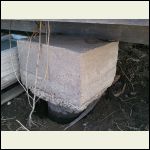
20140508_13.26.18..jpg
| 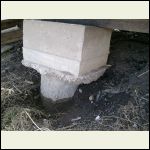
20140508_13.26.52..jpg
| 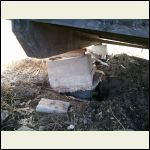
20140508_13.55.35..jpg
|  |
|
|
Just
Member
|
# Posted: 9 May 2014 05:37pm
Reply
looks like your wright, sounds like a good solution . looks like some ground water A
JUST
|
|
bldginsp
Member
|
# Posted: 9 May 2014 06:12pm
Reply
Wow- worst case scenario. Since its just 10 x 16, what do you think about just leaving it on skids on the surface and letting it ride the surf?
|
|
OwenChristensen
Member
|
# Posted: 9 May 2014 06:13pm
Reply
The ground has sunk away. It lifted right at the top, I would guess. It looks like that extra concrete at the top made contact with lifting ground.
|
|
jackaxe
Member
|
# Posted: 9 May 2014 06:23pm
Reply
It was a tough winter. Here in NY, 42-48" min. I like the tubes. I have redone 6 out of 16 so far. I use a 8" tube for a 6x6.
|
|
PatrickH
Member
|
# Posted: 9 May 2014 06:28pm
Reply
The frost went unusally deep this year, there where alot of water mains breaking here in the Twin Cities area of MN. one broke on our lot at work.
|
|
Don_P
Member
|
# Posted: 9 May 2014 06:29pm
Reply
The girder appears to be rolling. Make sure they well braced back to the joists in several locations before jacking or disturbing anything. If there is enough grade to french drain around the site and dewater it to daylight it'll help with the future foundation. At 10x16 I'd put it on a trailer, build a good foundation and bring it back in.
|
|
Wilbour
Member
|
# Posted: 12 May 2014 08:14am
Reply
Quoting: OwenChristensen It lifted right at the top, I would guess. It looks like that extra concrete at the top made contact with lifting ground
I think this is correct. The shoulder was lifted by the ground allowing water/clay soil under the concrete. I discovered how wet the soil is when I got my car stuck in the clay. Talk about making an impression on the locals  . I am thinking it's gonna be a HUGE job digging out the piers and making room for a Bigfoot. With that much moisture in the ground at all times due to the clay mixture I'm thinking the best option is to support the beams on cinder blocks/gravel and remove the piers one at a time. When I have the lifting piers removed I will slowly lower the cabin to a more reasonable hight on the cinder blocks. . I am thinking it's gonna be a HUGE job digging out the piers and making room for a Bigfoot. With that much moisture in the ground at all times due to the clay mixture I'm thinking the best option is to support the beams on cinder blocks/gravel and remove the piers one at a time. When I have the lifting piers removed I will slowly lower the cabin to a more reasonable hight on the cinder blocks.
If all this works this summer I will repair the cabin. If this fails then I will abandon it and start from scratch.
|
|
|
toyota_mdt_tech
Member
|
# Posted: 12 May 2014 08:55am
Reply
Quoting: OwenChristensen The ground has sunk away. It lifted right at the top, I would guess. It looks like that extra concrete at the top made contact with lifting ground.
I'm with Owen. If the top wasnt belled out, flared, just a solid round tube clean to the frame, maybe the flare at the bottom of the hole, this probably would of never happened. Just out the old concrete, add gravel in the bottom, maybe those bigfoot units, then pour in concrete.
But as bldg insp mention, just ride it out on the skids is another option.
|
|
Wilbour
Member
|
# Posted: 12 May 2014 11:49am
Reply
Once the land dries out a bit I think I may just let it float on some gravel, a cement pad then a cinderblock. That means digging out the old piers by hand (ouch). This is way bigger than I want to tackle but I'm gonna have to give it a shot.
|
|
hueyjazz
Member
|
# Posted: 12 May 2014 11:59am
Reply
I too had big time frost heave problems this last winter. I've own my cabin for two years now and we do use it through the winter. It is built on 9 elevated wood piers. It is located in Upstate, NY near Swain. The deck and exterior walls were bowing towards the middle. I had no problems the previous winter but this year's actric blitz was the worse it has ever been around here. After the winter everything is pretty much back in place except a sliding door is a little cocked.
I do have an underground spring close to my cabin that feeds a pond. I wonder if this is playing a role. Under the cabin I could see areas of ground that were heaved as much as a foot but my piers only moved a few inches if that. Of course they should have moved at all. I plan to did down next to one of them and see how far the piers really go. I know they should be at least 4 feet down.
If not this job is really going to suck as digging every pier out and pouring concrete under will all have to be done by hand.
|
|
silverwaterlady
Member
|
# Posted: 12 May 2014 12:56pm
Reply
Guess what? We also have problems with frost heave. We will be doing work on our foundation this summer. Not sure what our son is going to do. He is having a friend that has more experience with foundations coming to look at it to give advice.
I will be posting photos of the work this summer on my cabin page.
|
|
OwenChristensen
Member
|
# Posted: 12 May 2014 03:53pm
Reply
Frost has no power without moisture, but with it watch out. That's why gravel works well, it drains. If it is soaked it will still heave.
A 10 x 16 should be fine on skids. The reason I say ''should'' is because I don't know how your cabin is built. If you have plywood or even OSB. siding it is stiffer and will be fine on skids. Better actually. If it heaves up, it will at least come back down. Like Wilbour said, dirt gets under a lifted post and it won't go back down.
Ps. you might be able to pull the posts out with a truck or tractor, just wrap a chain around them and pull after you have your new beams under the cabin.
Owen
|
|
toyota_mdt_tech
Member
|
# Posted: 13 May 2014 08:45pm
Reply
Quoting: OwenChristensen Ps. you might be able to pull the posts out with a truck or tractor, just wrap a chain around them and pull after you have your new beams under the cabin.
And after digging around them, could you backfill the concrete post holes with gravel and then a small french type drain to keep water away?
|
|
creeky
Member
|
# Posted: 14 May 2014 02:25pm
Reply
I too had a bit of heave this year. Nothing like yours though. I waited it out and the building has settled back into place.
My footings are 4 feet deep. I think the deck I put on levered the north side of the building (8x16).
So, thinking to either put some flying buttresses on the south side to counter the deck lever or just hope for warmer winters.
|
|
morock
Member
|
# Posted: 19 May 2014 08:01pm
Reply
I'm north of you outside of Ottawa. Wow did we have frost heave this year. If your soil is like mine and lots of clay you will find your holes are always full of water. You could contact Techno Post it would be a quick and easy fix using there posts, but the clay may not have enough support for posts or even a bigfoot. My favourite anti-frost device is 4 inch styrofoam around posts and under slabs. I get used styrofoam from a recycler who gets it off old flat roofs. It really works, even this year!
|
|
Wilbour
Member
|
# Posted: 20 May 2014 07:44am
Reply
It is so wet this year I have not been able to even attempt to fix this issue. I will try to stablize each corner. Then later I will set the beams on blocks resting on the ground. Honestly, each time I go out I wonder if it's still standing.
This is what you get when you purchase before the snow has fully melted!
We wanted the land and the cabin was a bonus. Now it may be firewood.
|
|
OwenChristensen
Member
|
# Posted: 20 May 2014 08:51am
Reply
I'm at odds with the experts on this forum. I believe any building in frost country should float on two major beams. Now this only works on sturdy buildings no wider than 20' and no longer than 28' or so., and that depends on sturdy plywood siding which can make them stiff. Two skids because three will cause differential lifting. Two might cause a slight tilt, but no damage to the building. This works the same as if your car were to set on frost, it moves, but doesn't break. I have a thirty year warranty on over three hundred small cabins in Northern , MN, and yet I'm still in business and use my real name and give all my customer my home and cell phone. Believe me , if this didn't work they wouldn't let me sleep at night. If I had one percent of failure I'd be out of this, and yet I've been at it now for nearly forty years.
|
|
Wilbour
Member
|
# Posted: 20 May 2014 01:40pm
Reply
Quoting: OwenChristensen I believe any building in frost country should float on two major beams
Good to know. I will still see if I can salvage the shed. If the gound would only dry up from this spring.
|
|
creeky
Member
|
# Posted: 21 May 2014 04:47pm
Reply
morock that's what I figure too. keep your frost line higher than your pier depth. and as you say about water in clay soil this year ... great point about isolating your posts from frost with insulation. xps foam is waterproof and will last for decades.
in our area this was the 100 year flood. whew. wet in the fall, lots of snow, more or less sudden thaw. add a 50 year cold winter. together. in our Ottawa.southeast On area. I would imagine ditto wolfe island... ny state. mn. reporting the same.
hueyjazz. have yu seen any settling/leveling. like you I had no problems last year.
just be patient wilbour. your posts should settle some. I imagine you've seen leveling by now?
|
|
Wilbour
Member
|
# Posted: 21 May 2014 10:54pm
Reply
Thanks for the encouragement. What has happened is the posts have tilted to 45 º and the beams are sliding off. I'm not going to worry about it. Although the floor is solid, the structure really is no all that well built. Worst case scenario is to salvage the floor and rebuild the walls and roof. Preexisting the bylaw I can rebuild the cabin.
|
|
Wilbour
Member
|
# Posted: 26 May 2014 09:32am
Reply
Looks like I may have just got there in time. I was able to jack up the shed and support the side with the rolling girder. Although the pier is still taking some of the weight, I managed to support the floor with cement pad and cinder blocks. The other girder was not rolling so I was able to use it fully with new support. One corner was amost entirely off the pier!
This summer I plan to dig out the footings and set the cabin back down to a reasonable hight letting it rest on the cement pads and blocks.
The Ground is entirely made up of clay and is still wet thanks to the late thaw and weekly rainfall. Neighbour assured me the ground does eventualy dry up and become hard just that this year it has been increadibly wet. There are some higher spots on the ground where I can pitch my tent since the cabin will have to wait until next year before I can sleep in it.
The blessing is the land is a couple of kilometers from a quiet sandy beach on Lake Ontario and just a 30 minute ferry ride to Kingston.
|
|
KinAlberta
Member
|
# Posted: 26 May 2014 03:17pm - Edited by: KinAlberta
Reply
Quoting: OwenChristensen 'm at odds with the experts on this forum. I believe any building in frost country should float on two major beams. Now this only works on sturdy buildings no wider than 20' and no longer than 28' or so., and that depends on sturdy plywood siding which can make them stiff. Two skids because three will cause differential lifting. Two might cause a slight tilt, but no damage to the building. This works the same as if your car were to set on frost, it moves, but doesn't break. I have a thirty year warranty on over three hundred small cabins in Northern , MN, and yet I'm still in business and use my real na
We have two old cottages here in Alberta and both are on blocks with a number of beams. Both have been very stable for years though had to be re-leveled periodically (maybe an 1"-1.5" due to blocks tilting and sinking slightly). Yesterday, I realized that the stability would have been even better had the cottages been cantilevered over the perimeter blocks so water would shed further from these foundation blocks. Instead with them along the edge of the building, rain water and snow melt can soak into the ground softening it and allowing the building to sink under its own weight. That said, over 60+ years, we've only added about a maximum of 4" of extra blocking along one side and zero extra blocking under the cottages or along the high sides (both sit on sloped land).
I do wish the buildings have been built with a second set of beams under the first set and perpendicular to them. This cross-hatch might have spread the load further from the most solid beams.
I believe trenching or some drainage solution to keep moisture even across the entire building footprint is the key to avoiding any uneven frost heaving. That way a building on blocks moves evenly - no piers required.
|
|
OwenChristensen
Member
|
# Posted: 27 May 2014 08:38am
Reply
Sounds good. I've been trying to design a better system yet. I know what I want , just have had some difficulty making it out of wood. I call it X-bracing. Two major beams running diagonally from corner to corner. If that could be done without loosing strength where the beam cross, this design would be great. Frost couldn't damage any rectangle shaped floor plan.
|
|
KinAlberta
Member
|
# Posted: 27 May 2014 11:14am
Reply
^ That sounds really interesting. Their intersection wouldn't matter in larger buildings as the beams would deflect at some point no matter what. A spoke system from a stable hub / pier might provide some benefit.
Regarding frost heaves, I think this guy is pretty reckless in terms of safety during his fixes (watch where he puts his hands), but otherwise offers some very informative information and observations in the video and then in the article.
It's well worth reading and watching his video:
https://woodgears.ca/cottage/foundation.html
|
|
Wilbour
Member
|
# Posted: 27 May 2014 11:51am
Reply
Quoting: KinAlberta Regarding frost heaves, I think this guy is pretty reckless in terms of safety during his fixes (watch where he puts his hands), but otherwise offers some very informative information and observations in the video and then in the article
That's pretty much my situation but my concerns with the guy on the website is that these braces are just 2 x 4s and they look to be jamed up to the subfloor. He should to what I may will end doing and that's to support the cabin on cinderblocks and remove the piers. Then lower the cabin to one block high off the ground. I can attest to the fact that clay is not a friendly medium to work with.
|
|
OwenChristensen
Member
|
# Posted: 27 May 2014 12:26pm
Reply
I have electric jacks that can lift a small cabin straight up three feet. They are wireless remote operated. I mostly use them to lift high enough to roll a trailer under and then set them back down again. Not to work under. Still , if done with common sense, could be done.
|
|
JJHess
Member
|
# Posted: 27 May 2014 10:44pm
Reply
I'm new here and maybe slightly biased, but if you don't want to deal with frost heave again call Techno Metal Post. You can find the nearest dealer on their website. Full disclosure here but I am a dealer for TMP in south central PA and have installed piles inside of several cabins for just this reason. I also am building a cabin for our family so I am not here to put in a plug for a company but share & get ideas for our cabin.
We also had a bad year for frost heave and we've already scheduled several jobs around PA to re-stabilize cabins and other structures. I'd look into going with a more permanent solution to the problem. But that's my two cents.
|
|
KinAlberta
Member
|
# Posted: 5 Jun 2014 07:32pm
Reply
^So do you cut holes in the floor and drill down from inside?
My guess is that installing piles just around the perimeter of an existing building subject to frost heave damage would wreak havoc.
|
|
JJHess
Member
|
# Posted: 6 Jun 2014 06:55am
Reply
Cutting holes and going from the inside is one way. We can also install right beside the structure and push the pile under the structure. We just have to relieve a little dirt from the back side so we can push it back.
Installing from inside is usually not that difficult. The attached pics show a cabin with a tile floor. They just pulled up a few tile, cut a hole and when we were done they put it back together. New wood beams were slid under the cabin and jacked up to support the floor.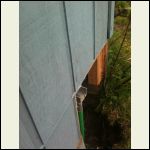
Picture1.jpg
| 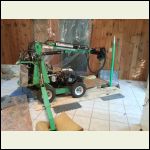
Picture2.jpg
| 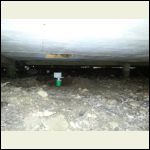
Picture3.jpg
| 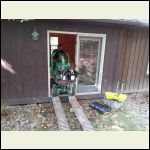
Picture4.jpg
|
|
|
| . 1 . 2 . >> |

